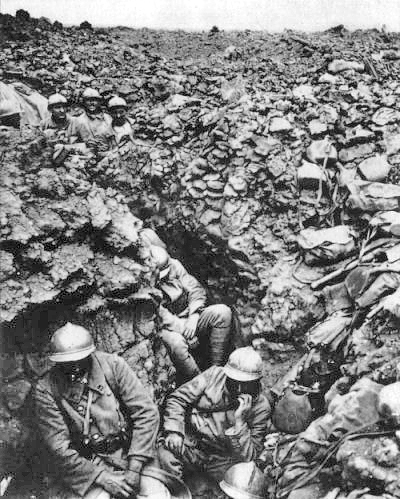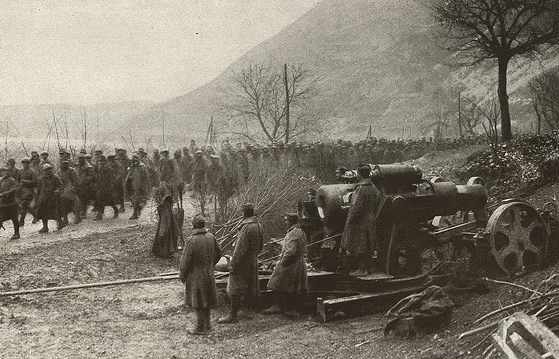This is the final part of a four part series on the summer of 1916:
This part examines some of the remaining events to unfold in 1916, as well as the long-term consequences of the Battles of Verdun and the Somme.
To begin, 1916 saw the Battle of the Verdun take a turn, and conclude. The French were desperate to restore the front lines to a location which made Verdun more secure, and launched major attacks throughout October. When the French moved new, massive artillery pieces into position, they began to knock Forts Douaumont and Vaux apart, leading the Germans to abandoning them without a fight, opting for more defensible positions further East. The French celebrated as if they had won the Western front, but they would continue their ill-advised attacks up through December. By the time both French and German commanders were ready to close the book on Verdun, casualties had reached nearly 500,000 on each side, with both Germans and French listing approximately 150,000 killed. By the time the battle ended, both sides were so exhausted that it was easy to mistake the living for the dead.

Meanwhile, on the Eastern Front, events proved equally violent. The French had begged the Russians to do something to ease the pressure at Verdun, and the result was the Russian offensive at Lake Naroch: a disaster. The Russians lost between 110,000 and 76,000 troops (12,000 of which perished from hypothermia), while the Germans counted only 20-40,000 in casualties. Later in the year, Russian general Aleksei Brusilov was given the authority to organize a broad offensive in which he pioneered new tactics: many localized, probing attacks designed to achieve one or two breakthroughs before the masses of troops were ordered forward to the weak points. The result was the greatest Russian success of the war: Brusilov’s army advanced approximately 50 miles, and successfully diverted huge numbers of German troops towards the Eastern Front. Even so, Brusilov’s army was but one of several involved in the attack, and the failure of another Russian army (led by Alexei Evert), combined with supply problems, spelled the end of the offensive, and also resulted in massive loss of life. The Russians counted over 500,000 casualties (440,000 dead or wounded), the Germans 350,000, and the Austro-Hungarians a staggering 975,000.

Back on the Somme: The British reasoned that such events proved that the Germans couldn’t possibly have pressed more troops into the area, and renewed their attacks up through November, even employing tanks for the very first time, albeit in rudimentary form.
Nevertheless, the Germans successfully defended the region, though at great cost to both sides. By the time the British finally gave up on attacks at the Somme in November, it had become a slaughterhouse to rival that of Verdun: combined French and British casualties numbered nearly 800,000, and the Germans counted about 540,000

In other news, Rumania signed a secret pact with the Allies in August, agreeing to enter the war on their side in exchange for Transylvania. It was perhaps the biggest miscalculation of the entire war: Rumania quickly invaded Transylvania, inviting a massive German counterattack which smashed the entirety of the Rumanian army. Rumanian retreats and surrenders would continue up through 1917, when a formal armistice was signed in December. Though the Rumanians had at times fought well (and had successfully diverted over 1,000,000 troops from the Central Powers), the end result was a little over 200,000 Central Power casualties, measured against over 550,000 Rumanian casualties, most of them prisoners. There are even reports of Rumanian troops being so shocked by battle with the Germans that they even tried to surrender to approaching Russian troops, their Allies. Supremely un-amused, the Russian commander in the Rumanian front found himself ordered to coordinate a join defense with the Rumanians. He replied that “trying to turn the Rumanians into a disciplined force” was like “trying to get a donkey to dance a minuet.”
While the inconclusive Battle of Jutland maintained British control of the sea, the real changes of 1916 were in political and military leadership:
Austrian Emperor Franz Joseph died in November, his Grandnephew Charles becoming the new emperor, and he wanted Austria-Hungary out of the war.
In August, Kaiser Wilhelm was convinced that Erich von Falkenhayn would never deliver Germany to victory, and elevated Paul von Hindenburg to the German chief of staff, effectively handing over all military decisions to Hindenburg’s chief strategist, Erich Ludendorff.
Joseph Joffre was replaced as commander of the French forces by Robert Nivelle the “hero” who had planned the assaults on the abandoned forts of Douaumont and Vaux.
Though Douglas Haig retained command of the British Expeditionary Force until the end of the war, Prime Minister H.H. Asquith was blamed for many of the disastrous strategic decisions, and was replaced by David Lloyd George in December.
Finally, apart from the Brusilov Offensive (which itself was also costly), the Russian experience in the war had been a series of defeats and disasters. 1916 represented proof that the Tzar’s regime would both continue in an ill-executed war, and do so against the will of the people. A revolution in early 1917 would dismantle his imperial government, and another in late 1917 would place the Bolsheviks in power.
We would do well to remember that wars are fought by men, but caused and prolonged by leaders. Though death from old-age, being deposed by revolution, and military replacement are regrettable fates, the real price for the war was paid by the men on the ground. In 1916 alone, the number of casualties would reach unbelievable numbers:
Britain- over 620,000
France- over 870,000
Russia- over 1,000,000
Germany- over 1,300,000
At night on the Somme, near Beaumont-Hamel, when the guns and rifles fell silent, the Germans would leave their trenches and wordlessly help the British sort through the piles of dead in order to find the few men who were still alive.



